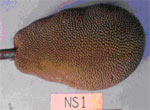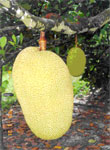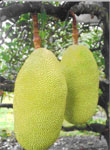| |
|
|
|
|
|
|
|
|
 |
| |
Being protandrous and highly cross-pollinating, the jackfruit shows great variability in tree, fruit and other characteristics.
Two major types of jackfruit are recognized based on the quality of edible pulp namely: The first type has thin edible pulp that is fibrous, soft and musky, acidulous to very sweet and produces a strong aroma when ripe. It is rarely consumed fresh and not very popular. The second type has a thick edible pulp that is firm or crisp that is less odorous. It is suitable for canning and fresh consumption. There are numerous cultivars in each type. There are about 30 cultivars in Malaysia.
The characteristics of selected jackfruit cultivars are described below. The popularly grown cultivars are J29, J30, J31, NS3, NS4, NS9, ‘Mantin Isi Merah' and ‘Kuning Rangup'. |
| |
Cultivar |
Size |
Fruit Characteristics |
Flesh Characteristics |
Notes |
Picture |
J2 |
|
High tendency to crack, poor shelf-life |
Sweet with a tinge of acid, moderate aroma |
Fairly old selection registered in the late 1930s |
` |
J27 |
Medium |
Elongated pulp unit and seed |
Thick-fleshed, orange, sweet with a tinge of acid, smooth texture |
` |
` |
J28 |
Medium |
|
Golden yellow, sweet, thick-fleshed |
` |
` |
J29 |
Medium to large (11-15 kg) |
Round, yellowish green skin, coarse spines, well-spaced, big seeds |
Medium-thick yellow orange flesh, fine texture, sweet, with strong aroma. Flesh recovery 33.3% |
Fresh consumption cultivar registered with DOA in 1973. Originated in Sg Chua, Selangor |

|
J30 |
15-18 kg |
Elongated fruit, greenish yellow skin |
Thick-fleshed, yellow, sweet with moderate aroma |
Registered with DOA in 1973 |

|
J31 |
Medium
(8-12 kg) |
Elongated to roundish, 45-55 cm long. Green skin, moderate thickness, a lot of latex, spines closely spaced, big pulp units |
Medium thick flesh, yellow, crispy, sweet, strong aroma with fine texture. Flesh recovery 31-35%. |
Previously known as NS1. Dual purpose cultivar suitable also for canning |

|
NS3 |
Medium to large
(9-18 kg) |
Round, greenish-yellow skin |
Medium thick flesh, yellow to orange, sweet |
Fresh-consumption cultivar |
` |
NS4 |
15-20 kg |
Oblong, yellowish-green skin |
Yellow, medium aroma, juicy |
Farmers' selection. For fresh consumption |

|
NS9 |
12-20 kg |
Elongated, green to yellowish skin |
Thick flesh, golden colour, crispy with strong aroma |
Farmers' selection. For fresh consumption |

|
Mantin Isi Merah |
15-20 kg |
Elongated with rounded end. Big fruitlets |
Yellowish orange, thick flesh, detaches easily. Mildly sweet, slightly juicy with slight acid taste. Flesh recovery 35%. |
New clone selected by growers |
` |
Kuning Rangup |
15-20 kg |
Elongated with rounded end, yellowish green skin |
Golden colour, sweet, crunchy. Flesh recovery 60%. |
New clone selected by growers. Highly popular as a dessert fruit |
` |
|
| |
|
| |
In Thailand, jackfruit varieties are separated into 2 groups according to flesh colour – the yellow flesh group is widely grown, weighs 7-15 kg, has a thick flesh that is crispy, sweet and fragrant. The yellowish-orange flesh group is less popular, weighs 7-15 kg and is also crispy and sweet.
In Indonesia, the nine commonly planted jackfruit cultivars are: Nangka bubur, Nangka bilulang, Nangka cempedak, Nangka dulang, Nangka kandel, Nangka kunir, Nangka merah, Nangka salak and wild jackfruit. The names almost always describe the quality of the fruits. |
| |
|
| |
|
| |
| |
| |
| |
|
|
 |
 |
 |
| Names |
| |
|
|
|
Artocarpus heterophyllus |
|
|
Common: |
|
English: |
Jackfruit |
Indonesia: |
Nangka |
Malaysia: |
Nangka |
Tagalog: |
Langka, Nangka |
Thai: |
Khanun |
Vietnam: |
Mít |
| Mandarin: |
Boluomi |
| Tamil: |
palap palam |
| Khmer: |
Khnol |
| Lao: |
Khanoon |
|
|
Taxonomic Position: |
| |
|
Domain: |
Eukaryota |
Kingdom: |
Viridiplantae |
Phylum: |
Spermatophyta |
| Subphylum: |
Angiospermae |
Class: |
Dicotyledonae |
Order: |
Urticales |
Family: |
Moraceae |
|
|
|
 |
 |
 |
|
| |
| |
|

